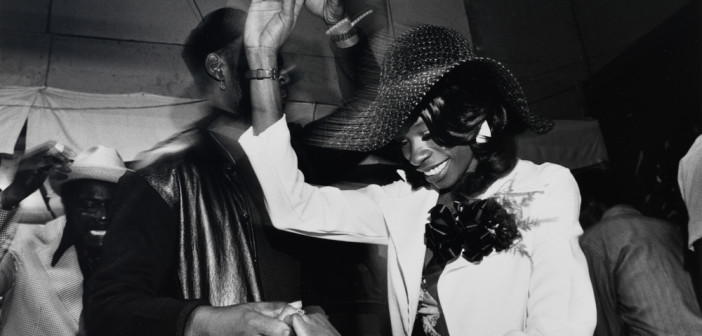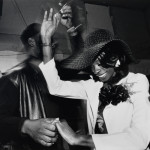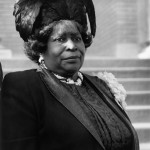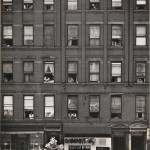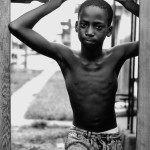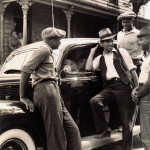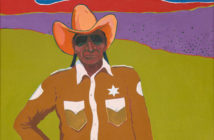 Earlie Hudnall, Jr., Lady in Black Hat with Feathers, 1990, gelatin silver print, Smithsonian American Art Museum, Gift of the artist. © 1990 Earlie Hudnall
Earlie Hudnall, Jr., Lady in Black Hat with Feathers, 1990, gelatin silver print, Smithsonian American Art Museum, Gift of the artist. © 1990 Earlie HudnallInterspersed throughout three galleries of vivid paintings and sculptures, the silver gelatin prints on view now as part of PEM’s new exhibition of Modern African American Art draw the eye with their subtlety. In Conversation culls nearly one hundred works of art from the Smithsonian American Art Museum’s extensive collection, representing more than seventy decades of creative achievement. But if you aren’t familiar with all of the photographers just yet, consider the reason: many of them made art, not only long before most museums would begin to take photography seriously, but at a time when they hardly took African American artists seriously. Roy DeCarava, one of several In Conversation photographers working during segregation, put it this way: "A black painter, to be an artist, had to join the white world or not function — had to accept the values of white culture." But in 2013, in PEM’s new exhibition, black artists speak for themselves about the values of their own cultures, manifold though they might be.
In Conversation is a dialogue about African American experience, representation, and community, one intended to get museum-goers talking about the marked differences between self-presentation and the portrayal of minority groups by others. Adding their creative voices to the discussion are a roster of renowned photographers: Roy DeCarava, of course; well-known Gordon Parks and lesser-known, but no less accomplished, Robert McNeill; portraitists Earlie Hudnall Jr. and James Van Der Zee; Roland L. Freeman, Tony Gleaton, and "Soulsista" Marilyn Nance. Street and documentary photographs are coupled with portraits from the 1920s through the early 1990s, giving us a wide angle onto black communities within a historical period of tremendous political, social, and, as we see, artistic activism.
Whether in the neighborhoods of Baltimore or the fields of Virginia, in houses of worship or the blues club, leaning from apartment windows onto the view below or posing for their portraits with stage props, this exhibition is about identity, and, further, about having the social authority to articulate and claim that identity. The sage words of bell hooks, in part of the wall text that winds its way throughIn Conversation, make the political dimensions of photography abundantly clear: "Though rarely articulated as such, the camera became in black life a political instrument, a way to resist misrepresentation as well as a means by which alternative images could be produced." Here, those images include Harlem Renaissance portraits by James Van Der Zee and Ray DeCarava’s determined "Mississippi Freedom Marcher". Van Der Zee’s 1922 "Evening Attire" presents us with a poised and elegant young woman in a wide-brimmed hat, mink shawl, and embroidered gown, gracefully holding a basket of flowers before her. In all of the work on view, African Americans are portrayed, as DeCarava had expressed his desire to see, "in a serious and in an artistic way," whether as individuals, as neighbors and families, or in their relationships with one another, with the land, music and spirituality, or the community.
The photographers’ work is so broad in scope, encompassing lived realities and long histories, that it cannot easily be reduced to themes. The picture presented here is nothing if not detailed and comprehensive. But some of my favorite photographs by Roland L. Freeman and Earlie Hudnall Jr. are quite specific in their focus on black masculinity, and on men’s relationships with each other and their families. Freeman began his career in the 1960s photographing the Civil Rights Movement, and is perhaps best known for his study of black culture and folklife throughout the African Diaspora. His "Bikers Take a Break," a 1973 photograph from the Southern Roads / City Pavements series, is set in his hometown of Baltimore, Maryland, and features several bare-chested young men in skinny jeans, some sporting neckerchiefs and afros. They have parked their bikes and removed their stars and stripes helmets. Smoke curls from the mouth of one biker who has just taken a drag on his cigarette, while another runs a comb through his afro. In the foreground, a young boy walks by at just the right moment, eye-level with the motorcycles and gazing off into the distance.
"Bikers Take a Break" is a time capsule, as much of an era, of Black Power and sociopolitical activism, as of a momentary break in the park. Against tired stereotypes about African Americans at the time, these men radiate a sense of pride, solidarity, and Afrocentric beauty that could be best put this way: Black is beautiful. Hudnall, Jr.’s 1990 portrait "The Guardian" gives the lie to yet another stereotype about black men, this time in their role as fathers. The scene appears to be a parade or demonstration of some kind. It takes place in a city, that we can see from the reflection of skyscrapers in the father’s sunglasses, and must be brisk outside. He dons a winter coat, and his daughter has bundled up against the chill. But she is evidently still cold, and her father shelters her between his arms, his coat wrapped around her. She is smiling, nurtured. There is a small, hand-held American flag on a stick tucked behind the man’s sunglasses as he looks right of camera toward the distant ongoings.
 Robert McNeill, New Car (South Richmond, Virginia), from the project The Negro in Virginia, 1938, gelatin silver print, Smithsonian American Art Museum,
Robert McNeill, New Car (South Richmond, Virginia), from the project The Negro in Virginia, 1938, gelatin silver print, Smithsonian American Art Museum,© 1938 Robert McNeill
The flag patterns are a slice of Americana, as are the visual elements of automobiles, linens on the line, and windows open onto the cityscape, that create a narrative between the galleries. It calls to mind Robert Frank’s visual stitching together of The Americans from recurring signs, but the vision it presents is hardly grim. In In Conversation, the land itself is a concept and reality that reappears from one frame to the next, from Freeman’s 1974 "Horse-drawn Cultivator" in Mississippi, to Robert McNeill’s 1938 seriesThe Negro in Virginia. Photographing during the great migration of African Americans from the South to Virginia and D.C., McNeill was sponsored by the Works Progress Administration, but did not shy away from capturing the bleak realities of racism and segregation. His "Spring Cleaning" and "Laborer" reveal a plowman and longshoreman, respectively, workers both weary and composed. Like their forebears, they work hard, but are prevented from owning the fruits of their labor.
Relationships with the land are both reclaimed here and yet politically fraught. Tony Gleaton photographs the descendants of African slaves brought to "New Spain" from the fourteenth through the eighteenth centuries. His series Africa’s Legacy in Mexico and Africa’s Legacy in Central America give "a narrative voice by visual means" to "the Other," creating an "alternative iconography" in the place of stereotypes. Gleaton often photographs his subjects returning the gaze of his camera, and in "Familia Del Mar / Family of the Sea, Livingston Guatemala, 1988," it is a child in the foreground who does so, cradled in the arms of her mother who stands with her back to us, watching her husband as he prepares a trawling net in a wooden rowboat. He is knee-deep in the water, the open expanse of the sea, upon which his ancestors came to New Spain, behind him.
Marilyn Nance’s 1986 "Baptism," featuring a man and a woman dressed in white at center, takes place along the shoreline of the ocean, calling to mind the total immersion of Gleaton’s "Un Hijo de Yemayá / A Son of Yemayá," shot in Belize in 1992. Water is symbolic, of life and death, and of the historical migrations that connect cultures. Nance explores the spiritual dimensions of those cultures, from the Black Indians of New Orleans, to an African village in South Carolina, to churches in Brooklyn. Ultimately, the power of her photographs is one that is shared by all of her fellow artists in In Conversation: human connection.
 Gordon Parks, Harlem, ca. 1948, gelatin silver print, Smithsonian American Art Museum, Museum purchase through the Horace W. Goldsmith Foundation. © 1948 Gordon Parks Foundation
Gordon Parks, Harlem, ca. 1948, gelatin silver print, Smithsonian American Art Museum, Museum purchase through the Horace W. Goldsmith Foundation. © 1948 Gordon Parks FoundationAnd it is human connection, often through adversity, that provides the real narrative. While Gordon Parks is one of the most eminent photographers in the exhibition, his iconic images, including "American Gothic, Washington, D.C., 1942" and "Emerging Man, Harlem, 1952," are missing, as are his photographic essays of Malcolm X. The simplest and most straightforward explanation for their absence is that these prints are not within the Smithsonian’s collection. But on the whole, cultural criticism is more subtle in In Conversation, limited to photographs such as DeCarava’s 1950 "Two Women, Manikin’s Hand, New York" and Gleaton’s 1990 "Peluquería / Barber Shop, Oaxaca, Mexico," which present us with a white mannequin and a poster of haircut styles featuring all white men’s faces. The critique is there, but you might miss it. McNeill’s "Make a Wish" is more pointed; two black women, one leaning against the wall, another seated on a crate, and a man carrying a pail wait on the corner of 170th Street, New York. They are a part of what was at the time called the "Bronx Slave Market," as McNeill notes in his title. Seeking work as domestics during the Depression, the "Bronx Slave Market" is where black women, and some men, would wait for passing whites to hire them on the cheap for a day of menial and grueling housework.
But I had to wonder at the lack of more scathing social commentary in In Conversation. Perhaps, as a celebration of African American art and cultures, images like "American Gothic" would be out of place? Described as "an indictment" by Roy Stryker, head of the FSA under whom Parks worked, the photograph of Ella Watson standing with broom and mop before the American flag was Parks’ answer to the racial bigotry he observed in the nation's capital. He had himself been refused service at first a clothing store, then a movie theater, and then a restaurant before he asked Watson, a cleaning woman, to pose for him. While I believe viewers would benefit from overtly political photographs that present the realities of racism and bigotry in this way, I can understand the rationale for keeping In Conversation more subtle in that regard. More than anything, it is a celebration of African American creativity, communities and cultures, and achievement. As a reclaiming of identity on one’s own terms, it acknowledges the effects of racism, but is not subsumed by them. And its narrative thread, remember, is human connection, not the evils that drive us apart.
- Roland L. Freeman, Dancing at Jazz Alley. Chicago, Illinois, June 1974, from the series, Southern Roads/ City Pavements, 1974/ Printed 1982, gelatin silver print, Smithsonian American Art Museum, Gift of George H. Dalsheimer, © 1974 Ronald L. Freeman
- Earlie Hudnall, Jr., Lady in Black Hat with Feathers, 1990, gelatin silver print, Smithsonian American Art Museum, Gift of the artist. © 1990 Earlie Hudnall
- Gordon Parks, Harlem, ca. 1948, gelatin silver print, Smithsonian American Art Museum, Museum purchase through the Horace W. Goldsmith Foundation. © 1948 Gordon Parks Foundation
- Earlie Hudnall, Jr., Looking Out, 1991, gelatin silver print, Smithsonian American Art Museum, Museum purchase. © 1991 Earlie Hudnall
- Robert McNeill, New Car (South Richmond, Virginia), from the project The Negro in Virginia, 1938, gelatin silver print, Smithsonian American Art Museum, © 1938 Robert McNeill

